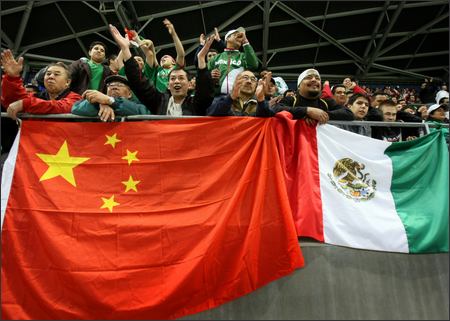Ay, Chinese Caramba: Cheap Cars Invade Mexico

As much as U.S. automakers, especially GM, rely on China to bolster their global sales numbers and to supply cheap parts, Detroit is scared excrementless that the Chinese may apply the Western technology which had been exported to their shores, and sell cheap cars in the U.S. So far, it hasn’t happened. But it’s happening in America’s underbelly and NAFTA partner Mexico. “FAW Group Corp., one of China’s three largest domestic auto manufacturers, has begun selling new cars for as little as $6,550 in Mexico in what is believed to be the first foray by a Chinese auto-maker into North America,” Canada’s Financial Post reports. This being a Canadian paper, they are probably talking Canadian dollars, so in real money, it would be $5550. Or more like $4999. Scary.
A boatload of about 6,000 FAW cars have been brought to Mexico by Grupo Salinas, a specialty retailer. “They’re not all sold,” company spokesman Daniel McCosh said. “The higher-end and the lower-end vehicles are moving better than the mid-priced models.” That Mexican beachhead is troubling news for Detroit.
Small, cheap cars are suddenly big in the US. “Small-car sales doubled during the first half of the year as gas topped $4 a gallon. By the end of November, sales levels had tumbled 63 percent from the peak. Even with the drop, the segment is holding up better than others because overall vehicle sales are so weak,” reported ABC News. Amazed even Ford Motor analyst George Pipas: “It’s surprising.” .
China’s central government, which controls FAW, has been pushing the export of Chinese-made vehicles. A push they need, because Chinese exports are going nowhere. China’s auto exports fell 46.5 percent in November compared to the same month last year, Gasgoo says, citing data from the China Association of Automobile Manufacturers. A scant 35,800 cars were exported from China.
Foreign “demand is quite unstable,” said David Zhao, a Toronto-based research analyst at Frost & Sullivan’s Automotive Practice. “FAW and other Chinese automakers are still implementing their globalization plans. But since the current financial crisis hit, their plan might be adjusted. For the moment, they still want to stay within the Mexico market. They want to accumulate experience.” They are building more than just confidence. FAW is building a car assembly plant in Mexico.

Bertel Schmitt comes back to journalism after taking a 35 year break in advertising and marketing. He ran and owned advertising agencies in Duesseldorf, Germany, and New York City. Volkswagen A.G. was Bertel's most important corporate account. Schmitt's advertising and marketing career touched many corners of the industry with a special focus on automotive products and services. Since 2004, he lives in Japan and China with his wife <a href="http://www.tomokoandbertel.com"> Tomoko </a>. Bertel Schmitt is a founding board member of the <a href="http://www.offshoresuperseries.com"> Offshore Super Series </a>, an American offshore powerboat racing organization. He is co-owner of the racing team Typhoon.
More by Bertel Schmitt
Latest Car Reviews
Read moreLatest Product Reviews
Read moreRecent Comments
- Lou_BC Let me see. Humans are fallible. They can be very greedy. Politicians sell to the highest bidder. What could go wrong?
- SPPPP Vibrant color 9 times out of 10 for me. There may be a few shapes that look just right in metallic gray, for example. There are a few nices ones out there. And I like VW "White Silver". But I'd usually prefer a deep red or a vibrant metallic green. Or a bright blue.
- 28-Cars-Later Say it ain't so, so reboot #6* isn't going to change anything?[list=1][*]V4-6-8 and High "Tech" 4100.[/*][*]Front wheel drive sooooo modern.[/*][*]NOrthSTARt.[/*][*]Catera wooooo.[/*][*]ATS all the things.[/*][*]We're *are* your daddy's Tesla. [/*][/list=1]
- MaintenanceCosts Can I have the hybrid powertrains and packaging of the RAV4 Hybrid or Prime with the interior materials, design, and build quality of the Mazda?
- ToolGuy I have 2 podcasts to listen to before commenting, stop rushing my homework.


































Comments
Join the conversation
@ra_pro: I'm sorry, you are wrong. You need to look at actual age distribution graphs before rehashing the "one child" stuff. China has no dearth of babies. The one child policy is already being relaxed. Even before that, only "35.9% of China's population was subject to the one-child restriction," says Wikipedia. The policy was enacted in 79. It will be 2040 before that generation retires. Europe and Japan had a de-facto one or no child policy since the early 70's (when the pill came out.) Birth rates halved. Germany's and Japan's population graphs look like nuclear mushrooms. The population peaks are heading towards retirement. A big reason for China's sudden growth was that a population peak entered the 20+ range, where you found families, need apartments, get jobs, buy refrigerators, cars .... Birth rates - whether affected by law or by personal choice - have a long lag time. Babies not born now won't be missed for decades. In Germany, the median new car buying age is in the 40's. That's where Germany's population peak is at the moment, and that's why you don't see the big contraction as in the US. In China, mass motorization has just begun. It has decades to grow just to catch up with motorization in Western countries. Even a zero child policy wouldn't affect that. In 30 to 40 years, it would. Mexico, by the way, has a very healthy population graph. The US looks decent, not as bad as Japan and Germany at all. The boomers are retiring. But they made more babies than Germans or Japanese.